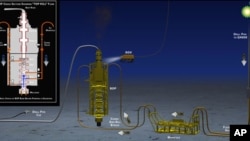BP oil company is making final preparations to try to seal off an undersea oil leak in the Gulf of Mexico, by filling it up with heavy mud. The company is relying on a method that has proven successful mostly on land.
BP officials say the best hope for stopping the oil leak this week rests on a procedure that has been used to stop countless oil leaks before, but never in deep water. For weeks, BP experts have been studying conditions, especially the intense pressure that exists at the well head 1.5 kilometers under water.
During a trip to the Louisiana coastline this week, BP chief Tony Hayward said there is still doubt about the procedure, in spite of the exhaustive preparations. "It has never been done in 5,000 feet of water. If it was on land, we have a high confidence of success," he said.
One of the initial hurdles posed by the broken well is how to connect tubes that will carry the mud from surface vessels into the well on the sea floor. BP has connected the tubes to a 450-ton piece of equipment called the blow-out preventer at the well head. The device was supposed to seal the well when it blew out, but failed to do so.
In a video posted on BP's web site this week, senior Vice President Kent Wells said teams have already repaired part of the blow-out preventer, or BOP. "We have successfully been able to activate two isolation valves so we believe we have put the functionality of that pod back to work," he said.
Another challenge the BP team faces is delivering the mud to the well head. On land, oil crews often have direct access to the well, but in this case, they must use a deepwater drill rig and remote-controlled submarines on the sea floor.
Kent Wells described how the mud will travel a long route, from a surface vessel into a drill rig called Q400, and then down towards the well. "From the pumping vessel [the HOS] the mud comes into the Q4000, goes down through the drill pipe, into the equipment we have put on the sea floor. It ultimately goes into the control valves of the BOP and starts fighting against the flow of the well," he said.
BP has deployed four pumping vessels to the area, which are capable of delivering up to 50 barrels of mud a minute. Still it is unclear whether it will be enough to stop the flow of oil, which is spewing from a well at least 5.5 kilometers below.
In case the top kill fails, BP says it is working on other methods to stop oil from leaking into the Gulf of Mexico. Wells says the firm has designed a valve system that can be used to cap the blow-out preventer and siphon oil to a surface vessel. "We believe by doing this we will create an option that will capture more of the flow that we have been able to capture so far," he said.
The ultimate solution for the oil leak is to drill a relief well that will intersect the existing well and choke the flow of oil. Two separate rigs are drilling relief wells now, but the work may not be finished until August. BP officials say they hope for success with at least one method of capping the well before then.













